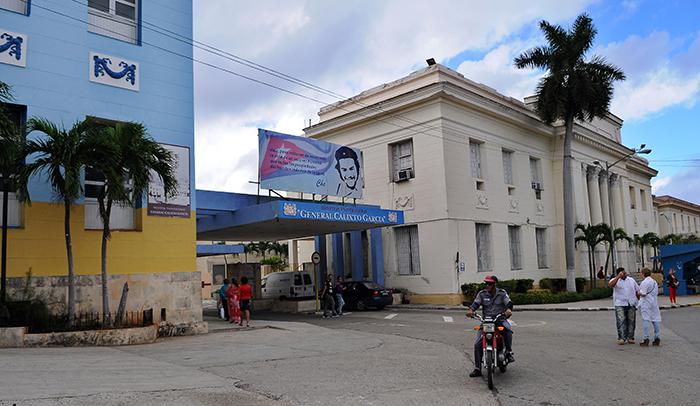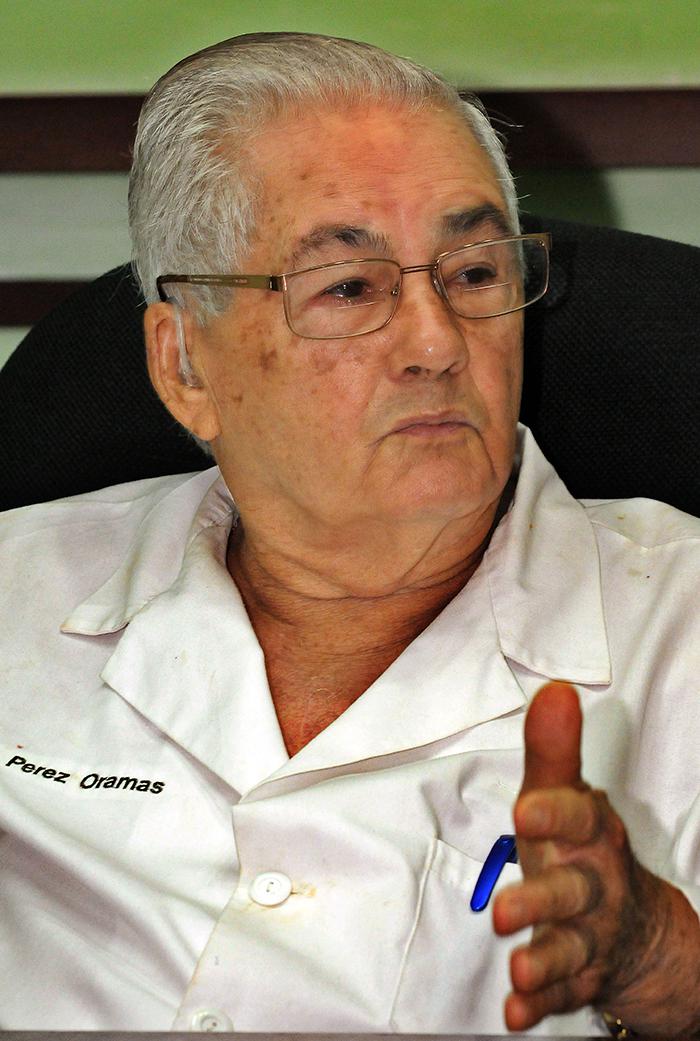
Havana resident Geovanni Barrueta Ordoñez, 44 years of age, happened to be in the city’s municipality of Cerro on New Year’s Day, when he began to feel heart pain. His family immediately took him to the emergency room at Calixto García University Hospital. He was admitted that very evening with high blood pressure and an irregular heartbeat revealed by an electrocardiogram. Geovanni told this reporter that he received rapid, quality medical attention, in both the emergency room and the cardiology department where he was resting.
A similar opinion was shared with Granma International by Dianelys Hernández Bello, who had spent the last 13 days and nights in the intensive care waiting room. Her 72-year-old uncle was hit by a car and suffered multiple traumatic injuries.
Other patients and their companions testified to the professionalism of doctors, as well as that of nursing and service staff here, which complements investments undertaken recently to provide maintenance and repairs at the facility, in addition to new updated equipment, as part of the process of needed improvement and reorganization being implemented by the Ministry of Public Health.

The hospital complex has reached its 120th anniversary rejuvenated, which has had a notable impact on medical services, as reflected in 2015 statistics: more than 150,000 patients admitted; more than 200,000 patients received in the emergency room - an average of 600 a day - of which 2,000 required urgent surgery. Some 150,000 patients received ambulatory treatment, and significant community work was done in the municipalities of Habana de Este, Habana Vieja, Centro Habana, Plaza de la Revolución and the Isle of Youth.
The Calixto, as the hospital is popularly known, was inaugurated January 23, 1896, bearing the name of the Spanish king Alfonso XIII, in a wooden building with a palm thatched roof, and capacity for 50 patients in each ward, eventually reaching a total of 2,200. It was located on University Hill, extending from the Castillo del Príncipe and G Street, on the south, to the University of Havana on the north.
At that time, the complex included 81 simple buildings, 50 clinical wards, 12 pavilions for contagious patients, six recuperation pavilions, and two isolated sites for malaria patients - with a staff of 27 doctors and 170 other workers.
In 1943, a Presidential decree gave the hospital its current name and transferred management to the University of Havana’s School of Medicine, to be directed by a board composed of seven professors. During the early years of the 1950s, the complex came to include more than 30 buildings, with 1,200 beds.
After the March 10, 1952 coup d’etat by Fulgencio Batista, the site became a refuge for students attempting to evade the ensuing repression, and a safe place to seek medical assistance for those wounded in demonstrations against the dictatorship.
LIVING HISTORY
Dr. Hernán Felix Pérez Oramas has been linked to the hospital since 1951, when he began his medical studies, which he was able to conclude in 1960. The Batista dictatorship closed the university toward the end of the 50s, and he was obliged to work as a nurse’s assistant for six months without pay, in order to secure a job.

“I witnessed a pathetic hospital. The medical wards and surgeries were overcrowded. When there weren’t enough beds, patients were placed on top of tables, boards, filling the halls and external walkways. Many slept on mattresses thrown on the ground, and even the entrances to the pavilions were used. I saw a great number of deaths everyday, and although stays were not charged, medicine had to be paid for,” the general surgeon recalled.
With the triumph of the Revolution, this chaos disappeared; the wards were organized by illness. Patients were admitted in accordance with their needs, not because some politician had arranged a sought-after bed to secure votes, or obtain a bribe from the family.
In 1959, the School of Medicine was reopened, and in 1965, the first 400 doctors trained by the Revolution graduated, a modest number given the country’s needs, especially since more than 3,000 doctors emigrated to the United States after the revolutionary victory. Only 13 professors and two specialists remained at the Calixto, yet today the hospital trains residents in 16 medical specialties and dentistry
In 1962, Dr. José Enrique Lara Tuñón began his studies, and described the active student movement of that decade, “The lack of doctors obliged us to link theory and practice, for those studying medical sciences, as well as for nursing and technical students. On the ground floor of the pavilions we provided services, and classrooms and teaching areas were set up on the first floor. We all learned by doing.”

The Calixto García also trained the professors who would give classes in the newly opened medical schools in several Havana municipalities and other provinces, and became the country’s pioneer in intensive and intermediate care.
“We established the first intensive care unit in 1972, just five years after this service was created in developed countries, with advisement from French specialists,” Dr. Lara said, “Several of our colleagues also trained in Spanish institutions. In intensive care, patients described as very serious are treated, with equipment in place to monitor their vital signs.”
Given the promising results obtained, after 1975, intensive and intermediate care services were inaugurated across the country.
One-year courses for anesthesiologists and internal medicine specialists were initiated. Today these are complex specialties which require three cycles of study, with exams every three months and at the end of each academic year, plus the defense of a research thesis before a professional jury.
Dr. Lara cannot make a distinction between his passion for the practice of medicine and his passion for teaching, saying, “I love to teach, preparing a class, giving a lecture, presenting an issue are a pleasure for me.”
Agreeing with him is nursing specialist Josefa Lourdes Fenton Tait, with more than 60 years in the profession, and working at the Calixto García since 1958.
“I am 83 years of age, and do not dare leave this hospital. I used to come into work before dawn and leave past nightfall. Now, I don’t have the strength to continue in assistance, but I give classes to third year nursing students at the intermediate level. I teach all the treatments a patient could require, beginning with registering those admitted, all the nurse’s actions until the patient is discharged from the hospital. At the end, an exam is given to evaluate treatment of a patient,” she added.
Hundreds of students from Africa, Asia and Latin America have studied at the
Calixto García and its staff members have participated in missions to many countries.
This was confirmed by those interviewed and by Dr. José Armado Socarrás Tirador, a general surgeon, “My entire career has been linked to this center. I was only away when I worked in Burundi from 1988 to 1990, in Colombia 1998- 2001, and the Kingdom of Bhutan from 2013 to 2015.”
He considers his experience abroad enriching, and has put what he learned into practice, he said, for example in quick decision-making in difficult situations. He trained colleagues in these countries as he provided care, and noted that language and ethno-cultural characteristics often present barriers, but can be overcome within a few months’ time.
Dr. Socarrás added, “I just returned from the Kingdom of Bhutan, located in the center of the Himalayas, in Asia, a very small country of 750,000 inhabitants, very poor, plundered by European colonizers. Upon arriving, local authorities examined us very rigorously. When we concluded out stay, the population wrote letters asking that the Cuban medical mission not be ended. That was a result of the affectionate care we provided residents.”
Dariana Vidal Martínez, 23, works at the Calixto García as a computer technician in the medical records department. She, too, insisted that the hospital has been a school for her as well. When she arrived, she was received with affection, and every day learns something new from her interactions with doctors and staff members, she reported.
Pulmonologist Humberto Cívico Quintero emphasizes the cohesion, the fraternal spirit which exists among all workers, the collaborative environment and unique mystique that lead him to describe the hospital as a school in the greatest sense of the word, appreciated by all “Calixteros.”
EXCELLENCE SOUGHT
In a conversation with GI, the hospital’s director, Dr. Carlos Alberto Martínez Blanco, explained that the Calixto García offers specialized medical attention, curative and preventative care, as well as rehabilitation services. Its patients have surpassed half a million and come from the adjacent provinces of Mayabeque and Artemisa, as well.
Supervised at the provincial level, the hospital has more than 531 beds, and 37 medical departments, but not Pediatrics, Gynecology and Obstetrics, or cardiovascular surgery. It is categorized as a level three institution within the Public Health system, additionally offering level two surgical services.
An extensive process of maintenance and repair is underway, including 42 projects of which 28 have been completed. The necessary financing is available for the rest, reflecting the government’s commitment to the work.
“In 2015, we undertook several projects of great importance, which have had an impact on the quality of medical attention. I am talking about the Marino Rojas Pavilion, where the clinical laboratory, the microbiology department, blood bank, and medical records are housed; the Gordon Anatomic Pathology Pavilion; the maintenance and transportation area. We are in the start-up process of the first phase of outpatient consultation services, and Neurosurgery. We are likewise working on the recovery of urban standards with the reconstruction of streets, walkways, sidewalks and parks,” the director explained.
The institution has among its responsibilities the development of promotional health activities with respect to prevention, recuperation and rehabilitation; planning, organizing, and directing educational work; undertaking scientific and technological innovation projects; in addition to epidemiological monitoring of the area surrounding the hospital.
The protagonists of these accomplishments are the 2,569 workers who make up the staff - including 56 who are currently completing internationalist missions – organized in 42 trade union units, of which 583 are doctors; 11 dentists; 435 nurses; 264 other health professionals; and 1,169 administrative, service and auxiliary workers.
The physical space is organized to reflect the over-arching concept of a university complex with teaching, research and service responsibilities, and just beyond its perimeter lie the School of Medical Sciences, the Center for Research on Longevity, Aging and Health, and the Gastroenterology Institute – independent institutions which are nevertheless part of a single entity.
“We have specialties, which given their ability to resolve problems, are of reference on the provincial and national level,” explained Dr. Martínez, “I am referring to our reconstructive surgery services for critically burned patients; the advanced management of complex cases involving multiple traumas; in the bariatric and spinal surgery departments, and that of traumatic injuries to the nervous system. We have extensive experience in middle ear surgery, as part of maxillofacial services; also in cases of head and neck cancer, with promising progress in cranial-facial reconstruction; as well as micro vascular surgery and minimal access operations.”
The Calixto García is intent upon consolidating its authority and prestige as an institution of and for the people, as an international and national reference in health care, especially in the comprehensive, multi-disciplinary management of emergencies, and a training center par excellence – for another 100 years.















